How to Do the Galápagos Islands if You Hate Boats
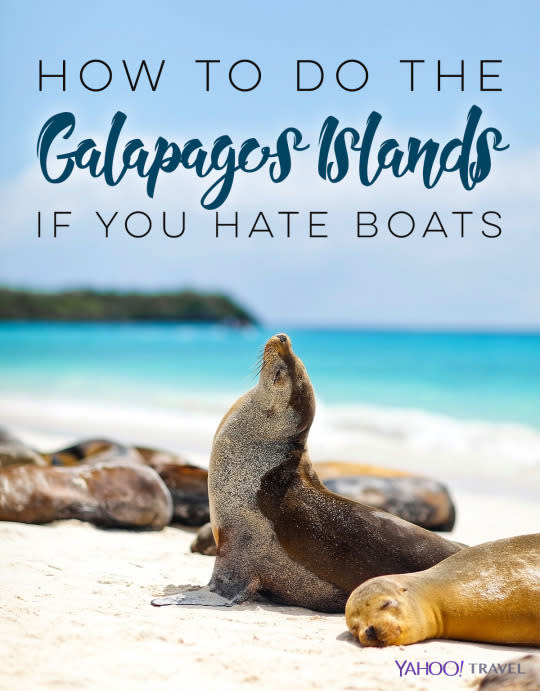
Are these little guys landlubbers too? (Photo by iStock, design by Lauren DeLuca for Yahoo Travel)
As it turns out, I’m a landlubber. I didn’t know the extent of it until I was sitting with my head in a rather small toilet in my cabin on a catamaran floating on the water off Santa Cruz Island in the Galápagos. And did I mention we were still anchored in the marina?
I was meant to have an amazing four-day boat tour with Intrepid Travel through the bucket-list-worthy Galápagos Islands in Ecuador. The islands are famously filled with cool and rare wildlife, and as an animal lover, I was ridiculously excited. But at that moment, instead of being giddy with anticipation, I felt like I was dying — and we hadn’t even hit the open sea.
“You’re seasick already?” said the tour guide, Oswaldo, looking at me in disbelief. I’d been on the docked boat for only 30 minutes, and we were facing about 18 hours a day on the ocean. “Did you take Dramamine?” he asked. Uh, yes. Yes, I did. It’s now circling its way down the toilet with my breakfast.
“The waves are at a 1 right now, and we’re going to be at a 7 or higher for the next four days,” he said in his cute little Ecuadorian accent, which I would have found charming were I not trying so hard to avoid puking on him. “You’ll never make it.”
So ended my much-anticipated catamaran adventure. But I’d just spent a full day and a half taking various planes, buses, and ferries to get to the Galápagos Islands from New York. It was the trip of a lifetime. I wasn’t about to give up.
Thankfully, as I found out (albeit the hard way), you don’t have to love boats to having an amazing time in the Galápagos. I won’t lie — you will have to spend some time on the water, but you can minimize seasick time and maximize pure enjoyment. Here’s how.
If you want to spend as much time on land as possible…
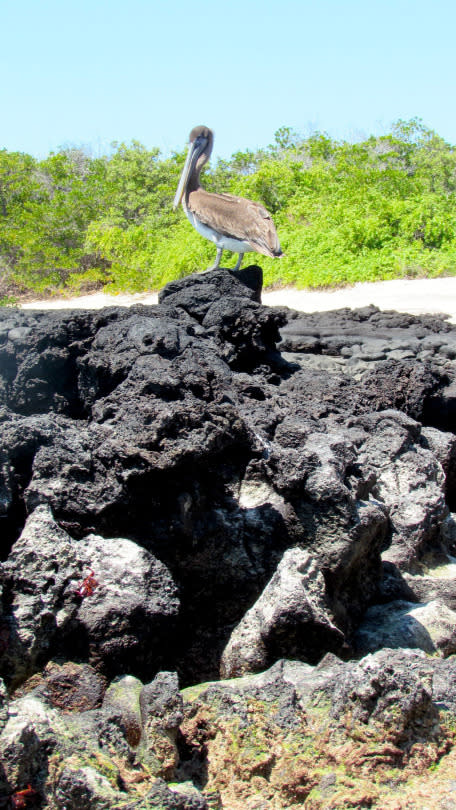
This pelican is looking for a little land time. (Photo: Leah Ginsberg)
The key to having a great experience with as little boat time as possible is staying on the inhabited islands and taking day trips to the smaller, uninhabited ones. Here’s how to do that:
1. Use a travel adviser.
It’s not so easy to arrange plans to travel in the Galápagos from the U.S. There are lots of quirks and restrictions and rules that you may not be aware of, plus many of the providers and accommodations don’t have English speakers. It’s not that you can’t do it on your own (especially if you speak Spanish), but finding a travel agent who is used to dealing with the islands will make your life a whole lot easier. (I worked with a woman from Intrepid Travel, which has offices both in Quito and the Galápagos. It also has great land tours available.)
Related: Obsessed With ‘House Hunters International’? Crew Tells How to Get Your Dream Travel Job
2. Choose a home base.
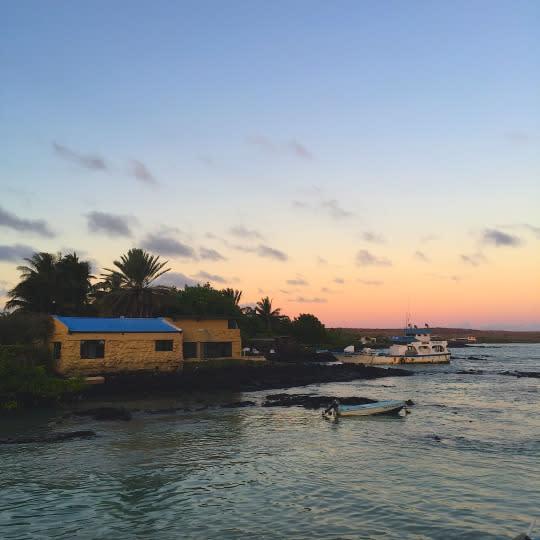
View from the Santa Cruz fisherman’s pier at sunset. (Photo: Leah Ginsberg)
I stayed on the main island, Santa Cruz, which is home to about 12,000 to 20,000 full-time residents (depending on who you talk to), and is a truly enjoyable little town with a lively marina area, shopping, and some yummy local food. (It’s so cute, in fact, I would recommend that even seafarers spend a night there.) There are a variety of hostels and hotels, so you can do it on the cheaper side (as low as $25 a night), or go all out (up to about $300 a night — Solymar is the fave fancy choice). I stayed at a Villa Laguna, where rooms start at about $100. Visitors can also stay on the islands of San Cristobal (around 30,000 people live there), Floreana (there’s a small village of about 250 locals), and Isabela (which has a population of about 1,800).
3. Spend time with the tortoises.

Found this big guy on the ranch. (Photo: Leah Ginsberg)
I wasn’t the only land-loving creature in the Galápagos. The Galápagos Islands are one of two places on earth where you can see giant land tortoises. (The other is in the Seychelles, also islands.) There are various places to see them, but two of the most popular are on Santa Cruz. The Charles Darwin Research Station is sort of a glorified zoo where you can learn about conservation and see hatchlings as well as adult tortoises. Or you can head to a tortoise farm in the highlands to see the creatures roaming freely. I was keen on going to a ranch. There are many, but locals told me the farm with the most tortoises is Rancho El Manzanitto — and it didn’t disappoint. The reptiles outnumbered the humans many times over. (This farm also happens to have a supercool lake that looks like it’s pinkish-red because it’s covered in some sort of algae.)
Related: 5 Ways Your Vacation Is Killing Sea Turtles
3. Book day trips to the various islands.
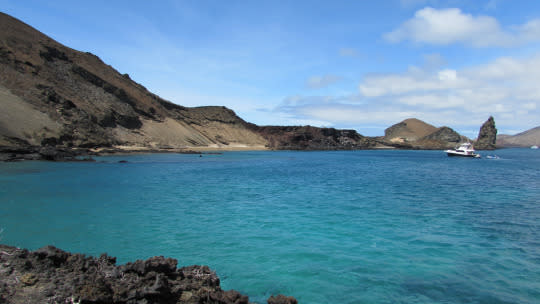
Isla Bartolome, with Pinnacle Rock in the distance. (Photo: Leah Ginsberg)
Here’s where the water inevitably comes in — but it’s much more bearable than full-time cruising if you’re prone to seasickness. And you can use the patch (more on this later) or Dramamine if you’re worried. These boat trips range from one and a half to four hours each way, depending on the route and the weather. You can book different day trips from San Cristobal, Santa Cruz, and Isabela.
From San Cristobal, you can explore Punta Pitt (on the north side of the island), Isla Lobos, and the famous Kicker Rock there.
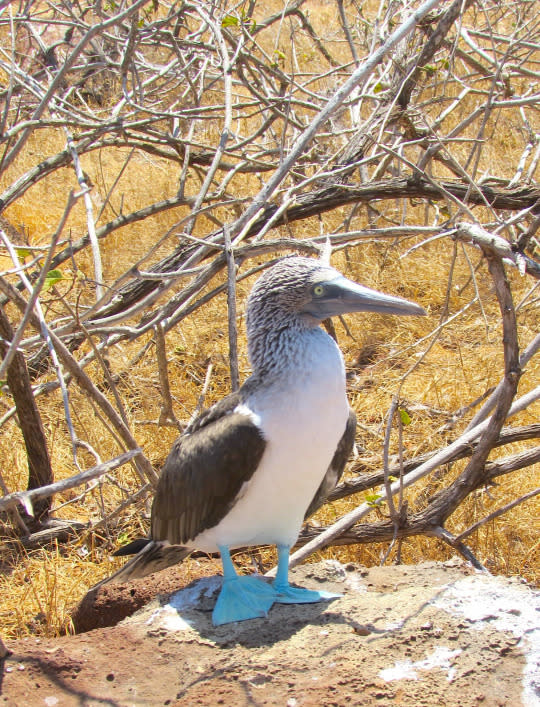
A blue-footed boobie. (Photo: Leah Ginsberg)
Day trips from Santa Cruz, my jumping-off point, go to North Seymour (home of the blue-footed boobies and red-throated frigate birds); Bartolome (where you’ll see Pinnacle Rock and mind-blowing views, and — if you’re lucky — swim with the cutest penguins you’ll ever see off nearby Isla Santiago), Santa Fe (sea lions galore) and South Plazas (catch sight of sea lion pups, iguanas, and colorful crabs). You can also get to San Cristobal and Isabela, as well as Floreana, from Santa Cruz.
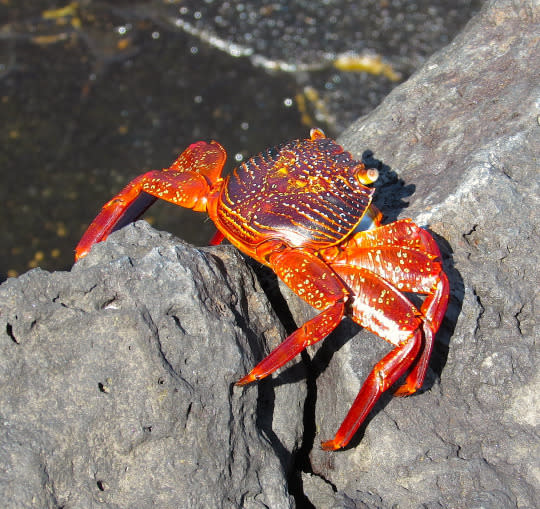
You’ll see crabs galore on many of the islands. (Photo: Leah Ginsberg)
Day trips from Isabela are just around the island. By land, you can do the hike to Sierra Negra Volcano, go to the Giant Tortoise Breeding Centre, hike to the wetlands to see Flamingo Lagoon, and go to the Wall of Tears. You will see tons of birds and marine iguanas. It’s also an amazing place to snorkel. Other travelers I ran into said they saw their first wild seahorses! Just one caveat — this boat trip, which on a good weather day is two hours, can be a bit of a doozy. You must go by public speedboat, and, because they’re pretty small, you can feel the bumpy ride.
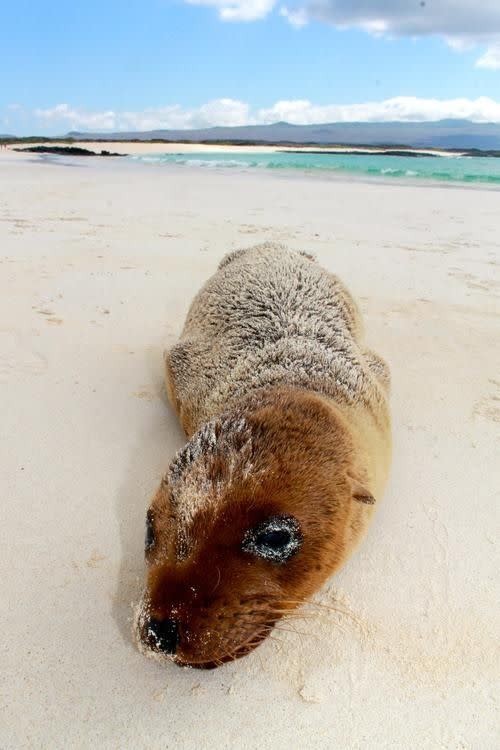
Don’t forget the sea lions! (Photo: Jo Piazza)
Because trips to the islands are highly regulated, there are a limited number of companies that run them, and you can go only to certain islands on certain days. Your travel agent can help you with this, but some of the most popular boating companies are Altamar, Queen Karen, Española, and Santa Fe. Day trips generally run anywhere from $100 to $200 per person, but also include one to two meals and soft drinks (alcohol is extra).
If you still want to brave a Galápagos cruise…
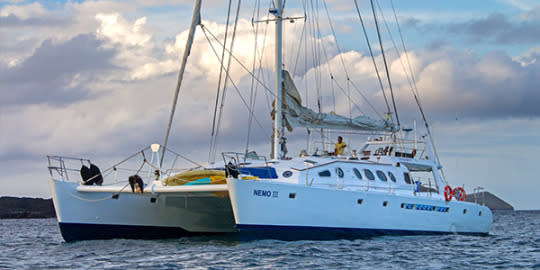
(Photo: Intrepid Travel)
As amazing as a land-based trip is — and believe me, it was amazing — boat tours (like Intrepid’s Glimpse of Galápagos, Central Islands, which I was supposed to be on) allow you to travel to farther-out islands that you just can’t reach otherwise, thanks to the government’s strict tourism regulations. For example, according to my Parque Nacional Galápagos naturalist guide, Philippe, only on a cruise are you likely to see fur seals (a different kind of sea lion) and albatrosses. And some of the snorkeling spots you’ll reach only by cruising are top notch. So if you’re up for it, here’s how to tackle a cruise:
1. Get “the patch.”
When you “cruise” the Galápagos, it’s on a small boat (like a catamaran), not your typical cruise ship. That can make you more prone to seasickness even if you typically don’t have an issue. And your usual dose of Dramamine may not be enough. So your best bet is to assume you will be seasick and get a preemptive prescription for transdermal scopolamine, also known as “the patch,” from your doctor. “It’s a little round Band-Aid-like patch you stick behind your ear,” says Vicki Sowards, a registered nurse and director of nursing resources for Passport Health. “Put it on a couple of hours before you hit the boat and replace it every 72 hours.”
It’s not perfect — Sowards warns that side effects can include dry mouth and it can make you feel generally crappy. And my tortoise-farm tour guide, Tom, told me he’d seen people have very weird and even dangerous reactions, though those details were sketchy and he admitted it was rare. But if the sea is your nemesis, this just may be your best defense. If I had been a little smarter and patched up, I would have been enjoying an amazing journey on a swanky catamaran through one of the most beautiful places on earth with my fellow travelers. Lesson learned.
2. Go when the seas are calmer.
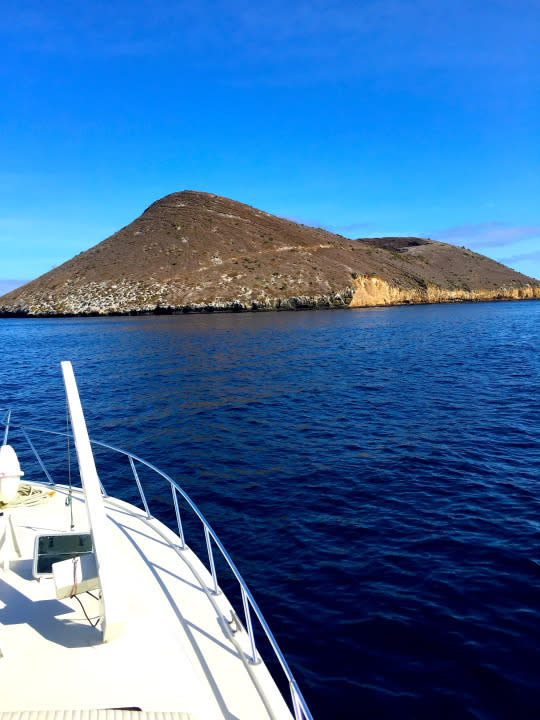
Calm seas are key. (Photo: Leah Ginsberg)
Though low season is a great time to see the Galápagos for several reasons (fewer crowds, cooler temperatures, lower prices), it also happens to overlap with part of the rough season at sea, which continues from May through October. If you don’t have your sea legs, you’ll want to choose a time when the ocean is calmer — January through March.
3. Pick a bigger boat.
The bigger the boat, the less likely you are to feel every dip and sway. For example, National Geographic has tours on larger boats, like its Endeavour. Just be aware that the big boats can’t fit into some of the smaller coves — and it could cost you as much as $10,000 a person, whereas the trip I was supposed to take with Intrepid runs more along the lines of $2,500 (prices for both depend on the itinerary, the boat, and the time of year).
Related: A Bucket-List Guide to Seeing the Galapagos
WATCH: Did Sinbad Get This Seasick?
Let Yahoo Travel inspire you every day. Hang out with us on Facebook, Twitter, Instagram, and Pinterest. Check out our original adventure travel series “A Broad Abroad.”
For more on Yahoo Travel’s travel policy, click here.
